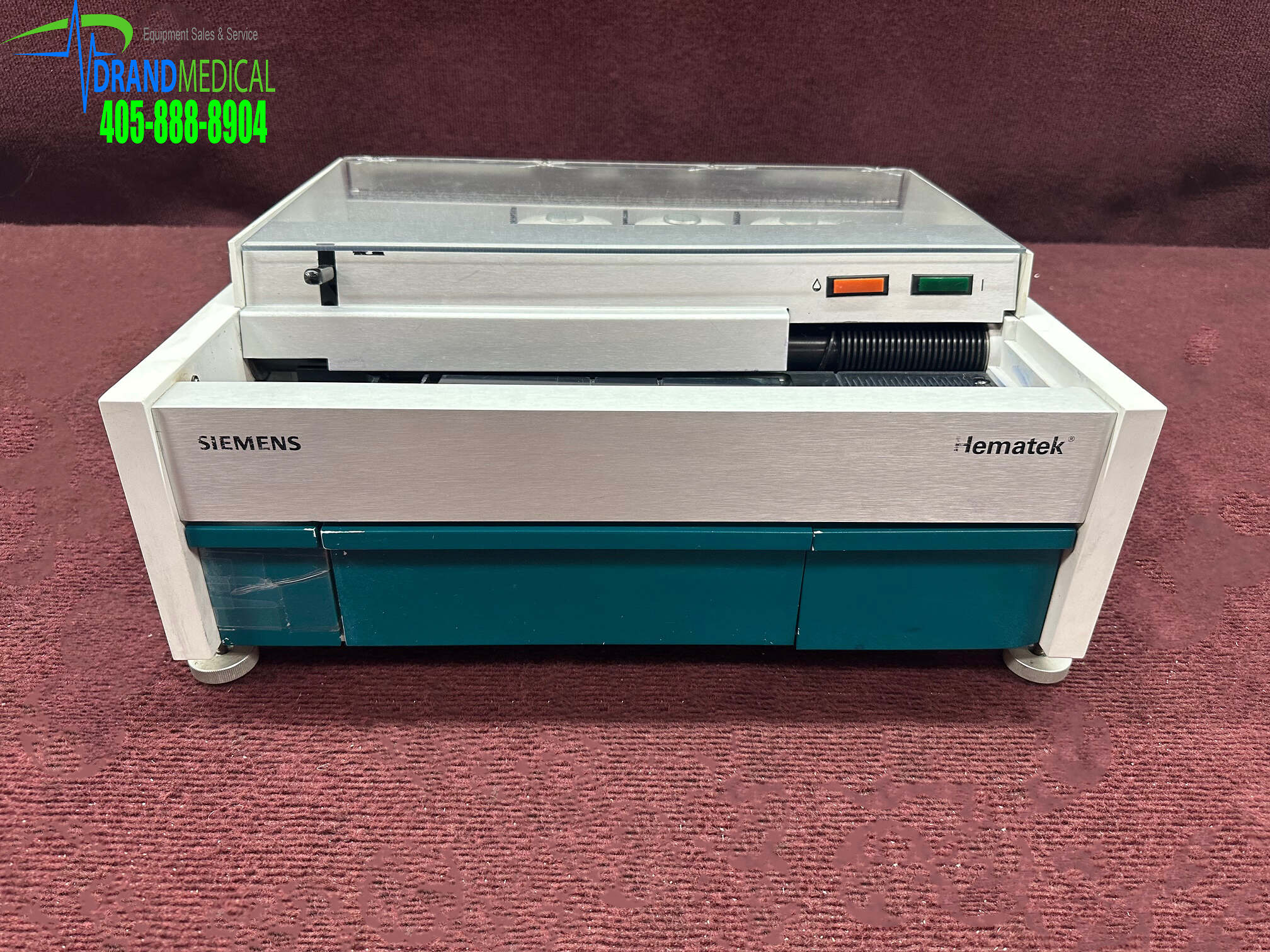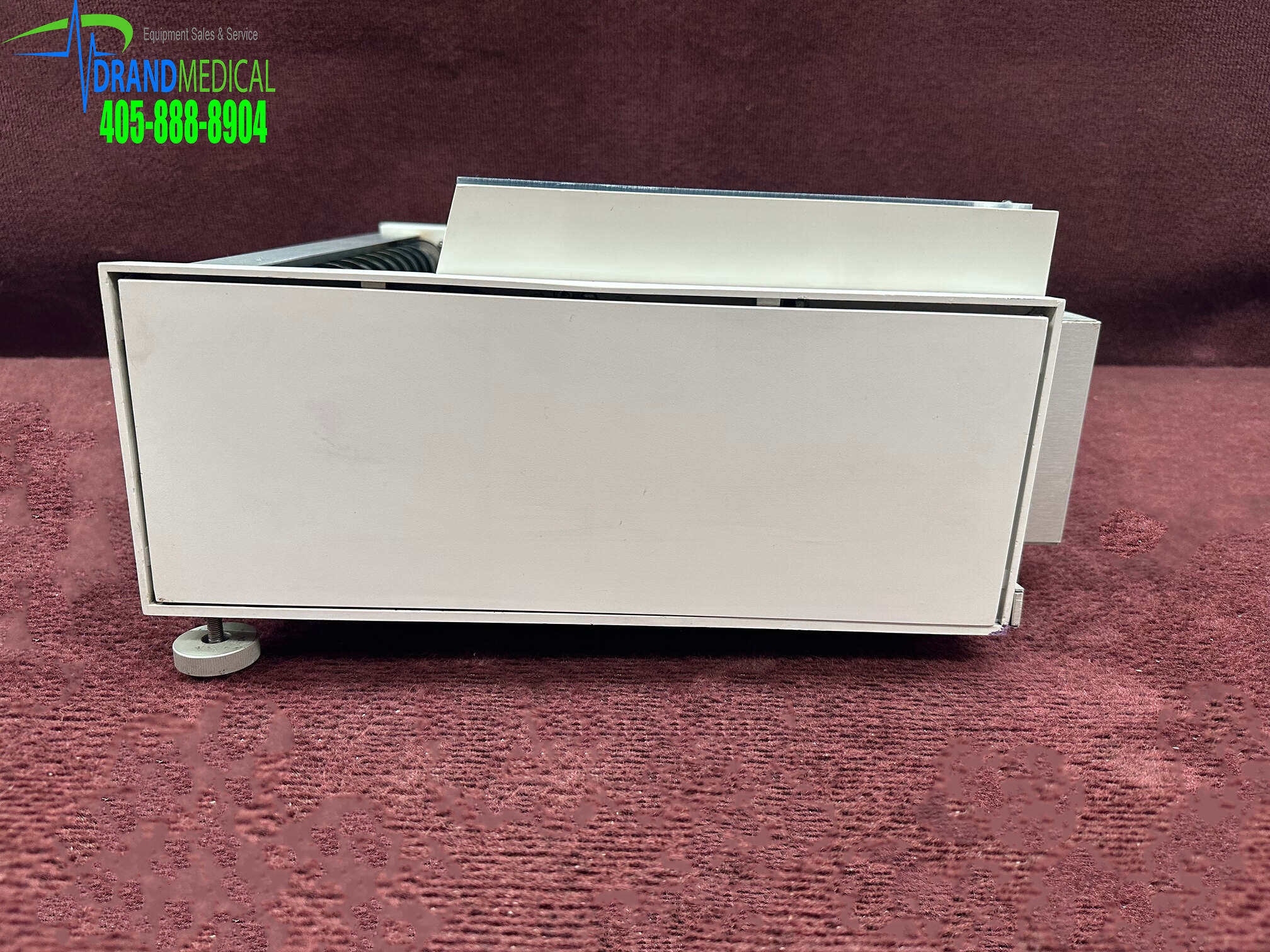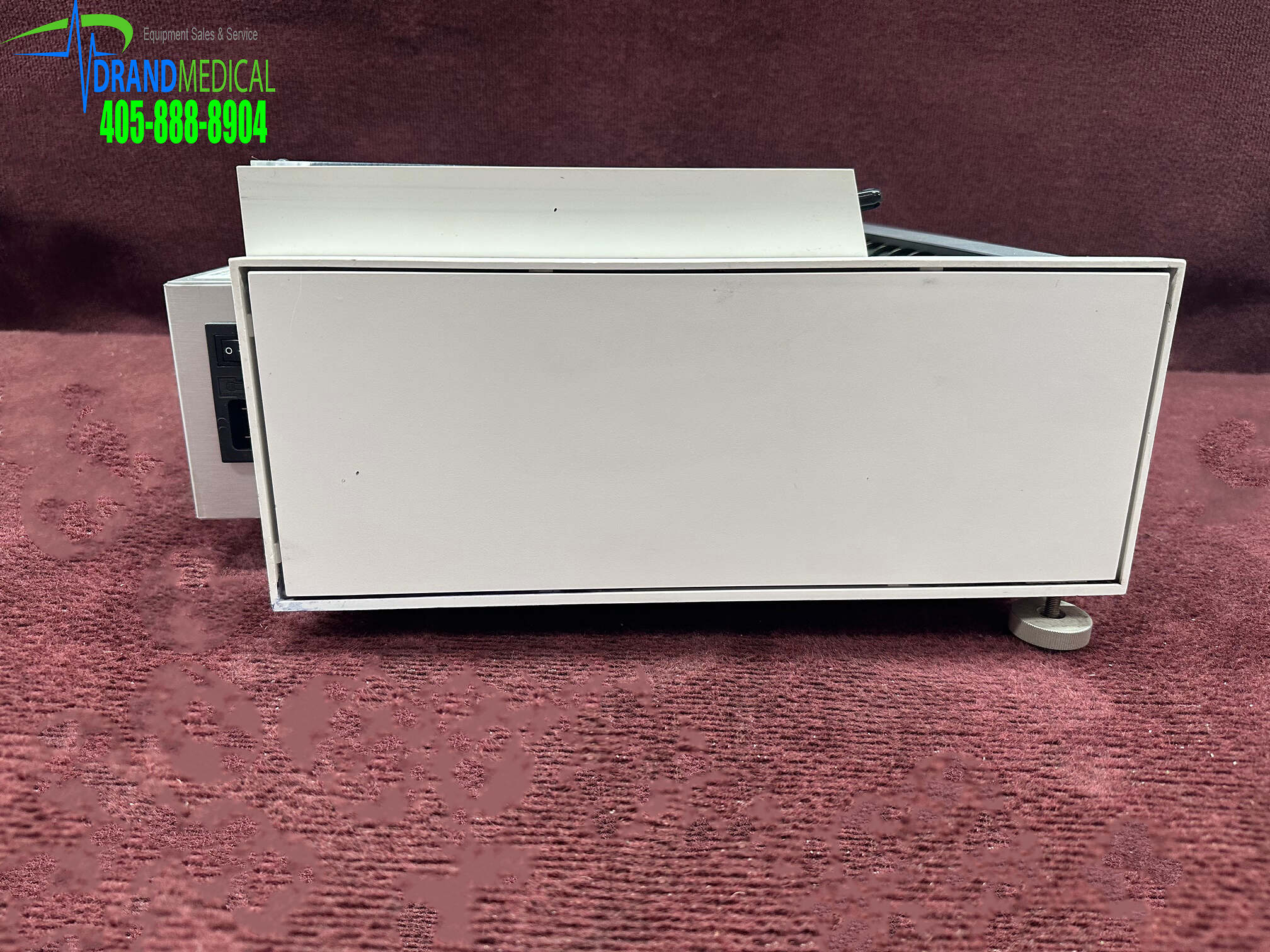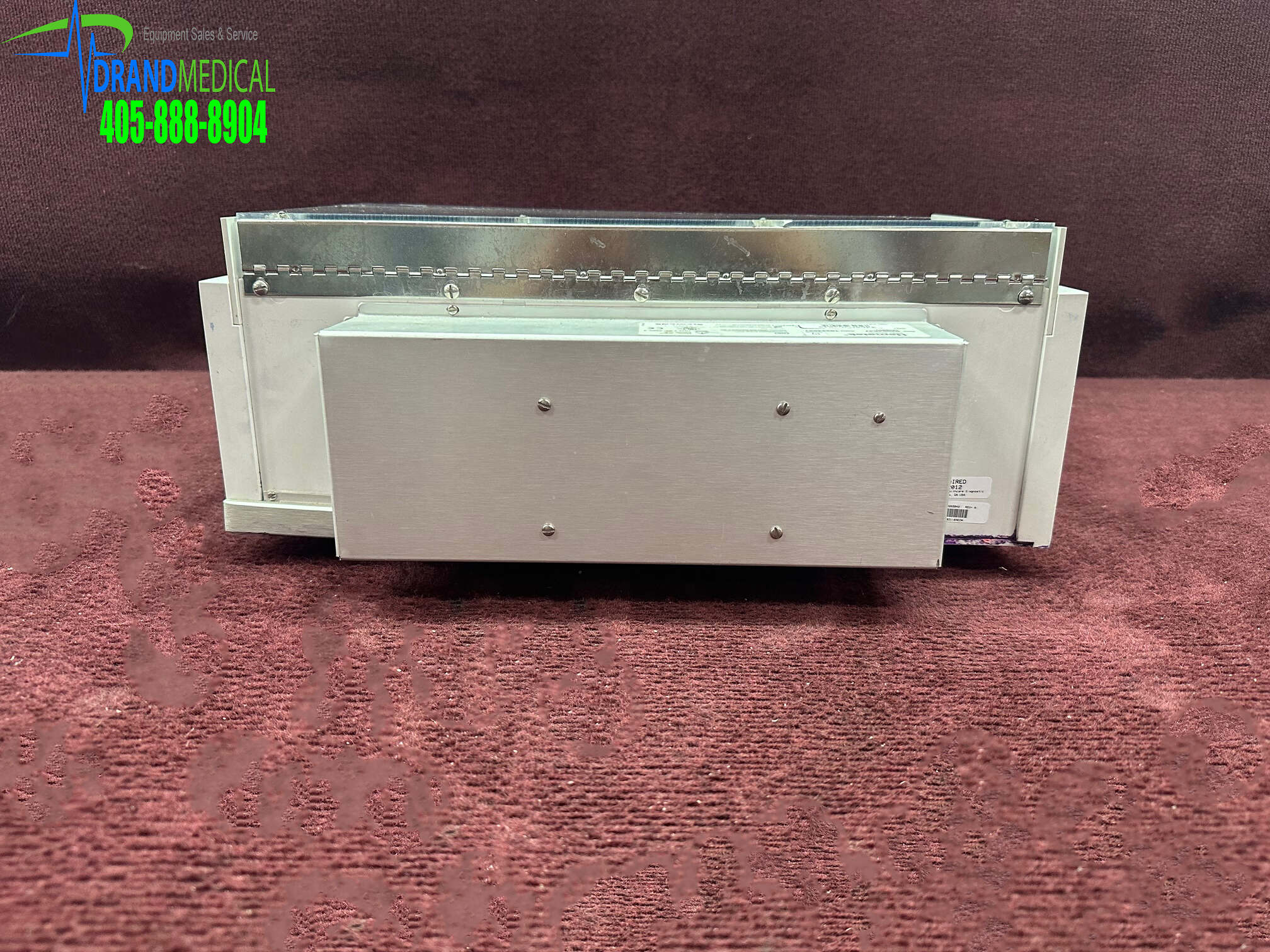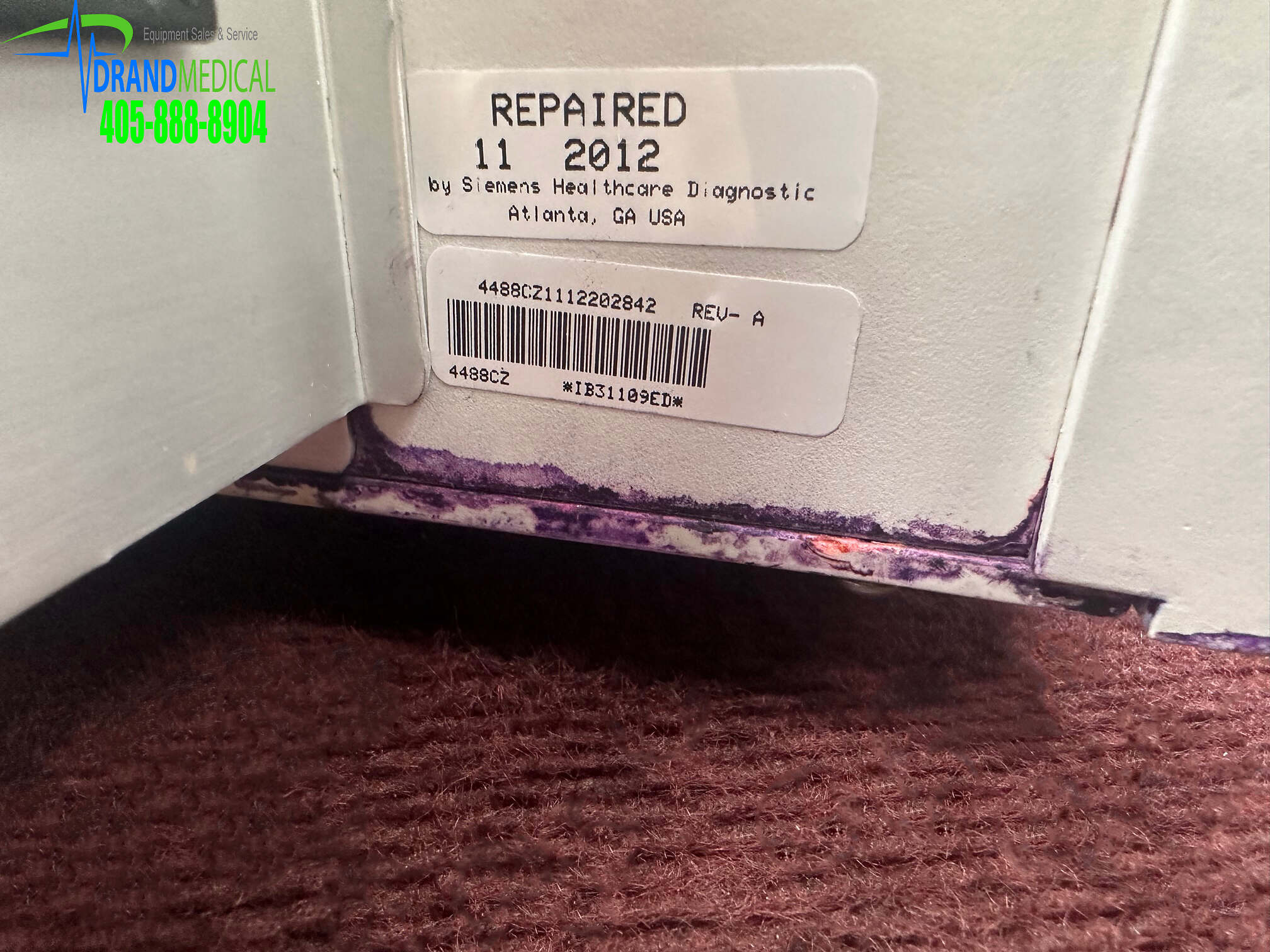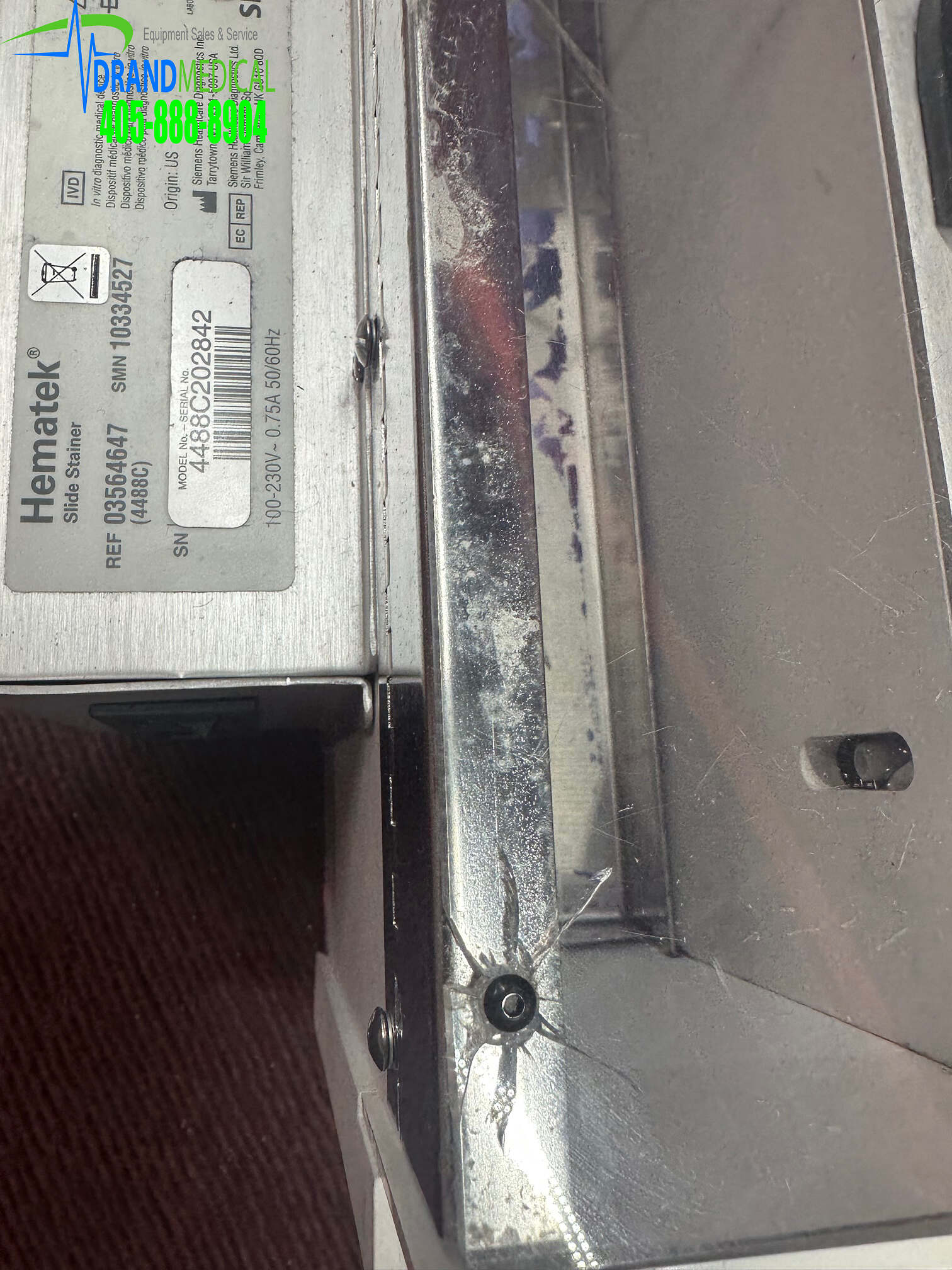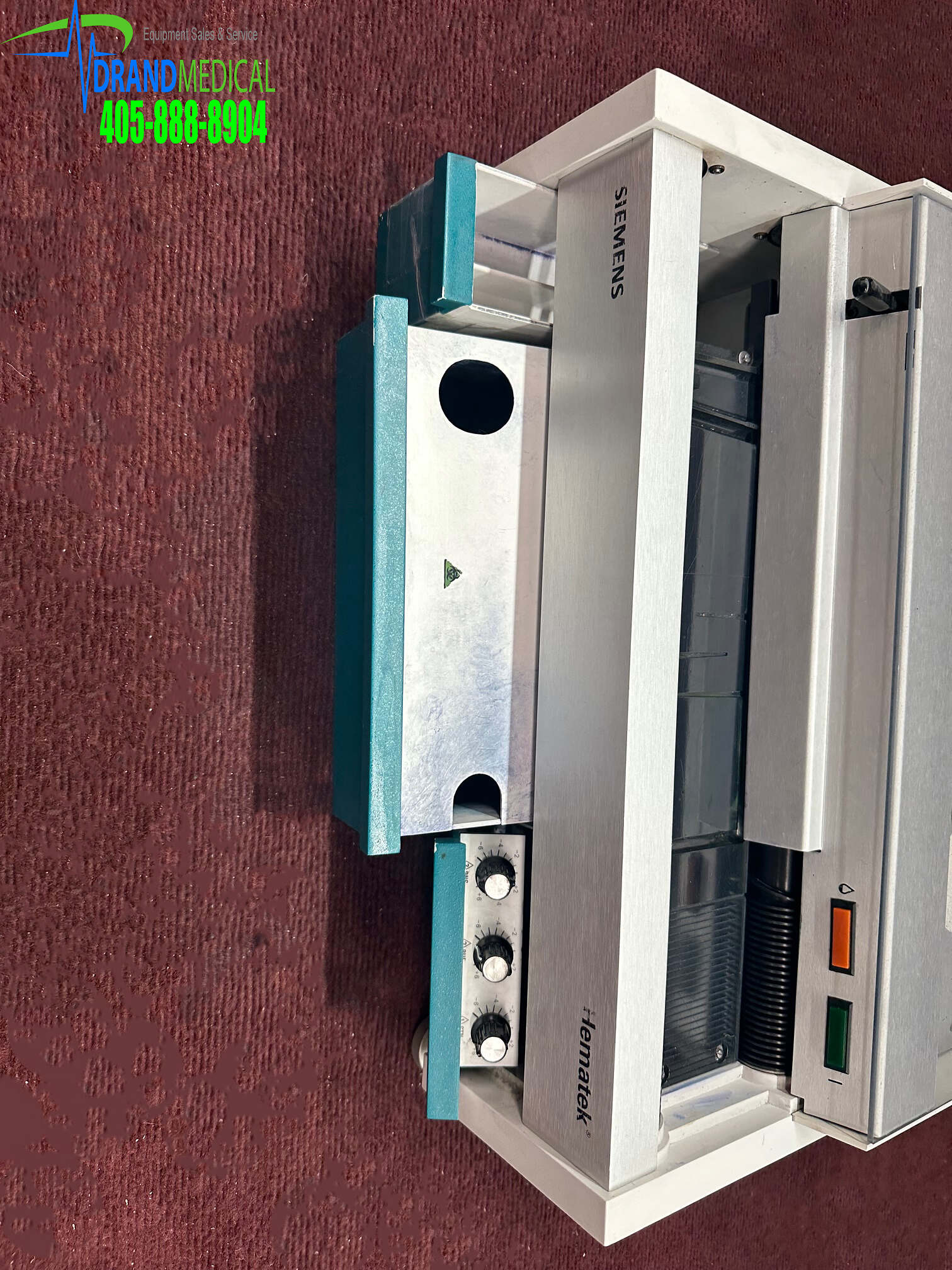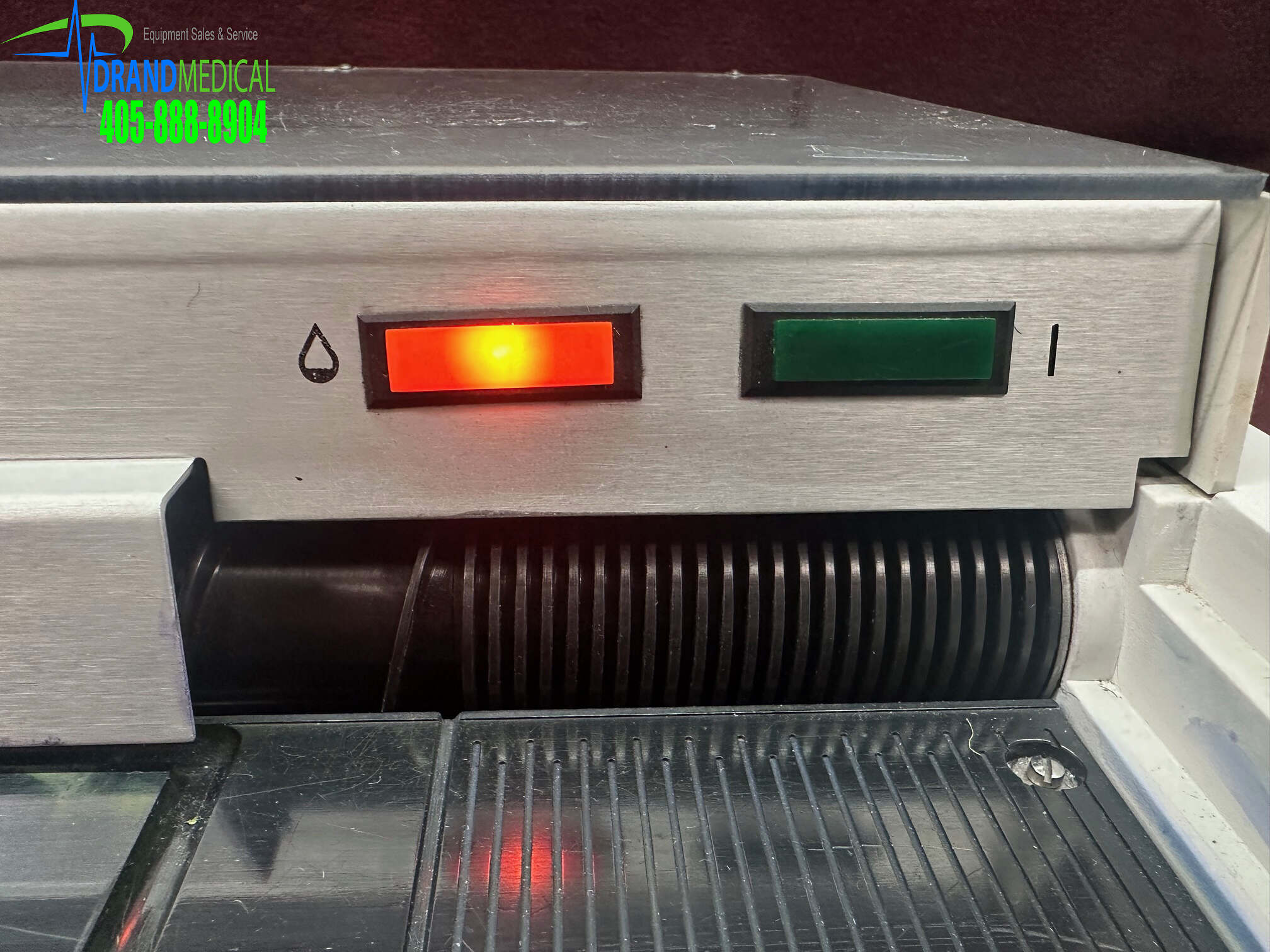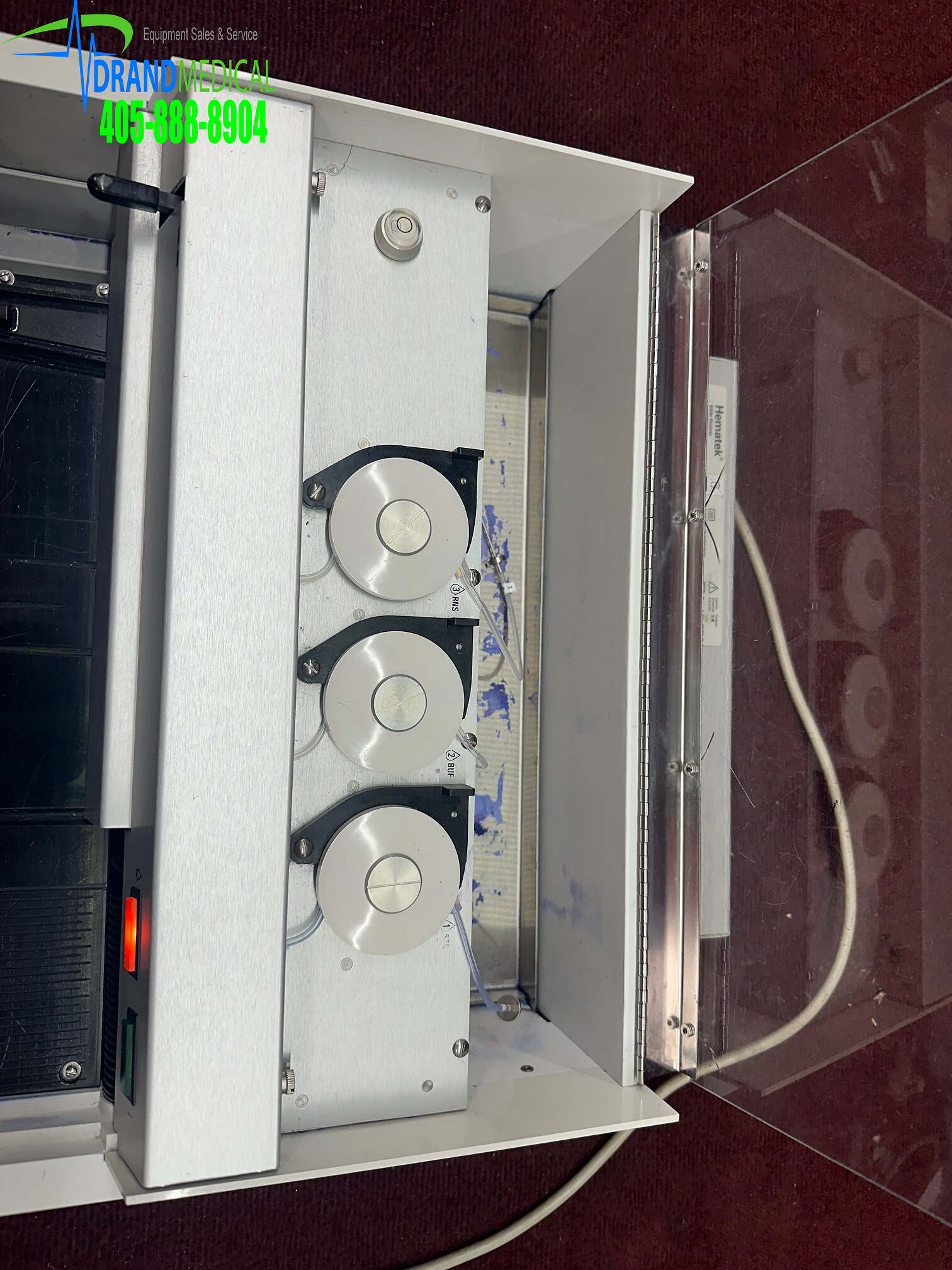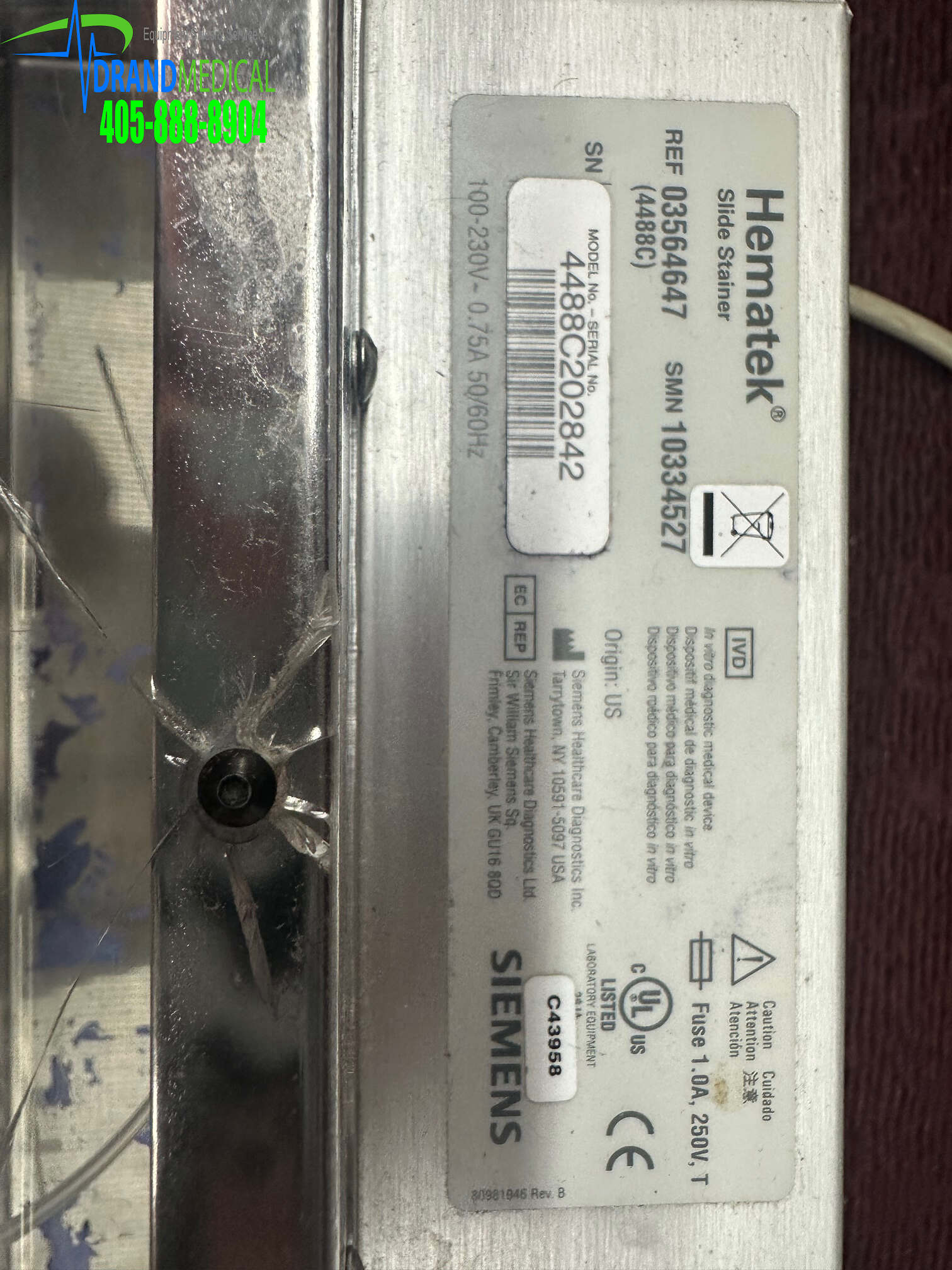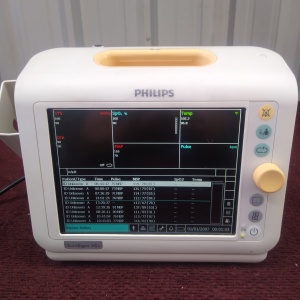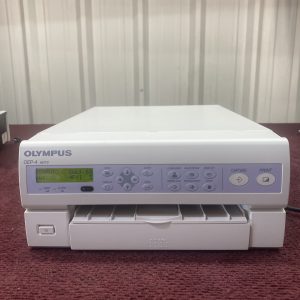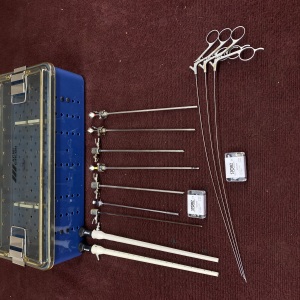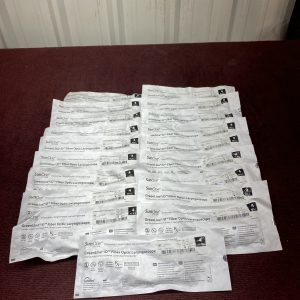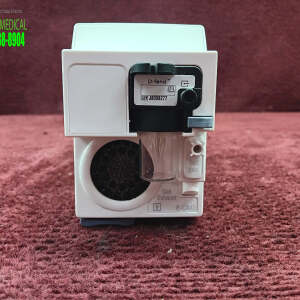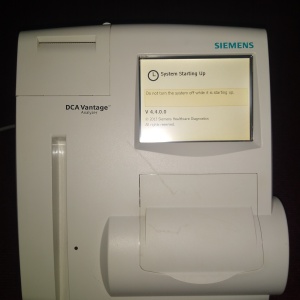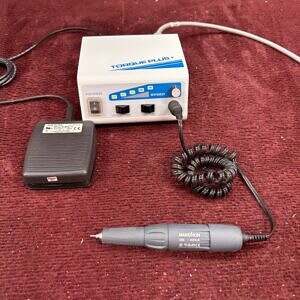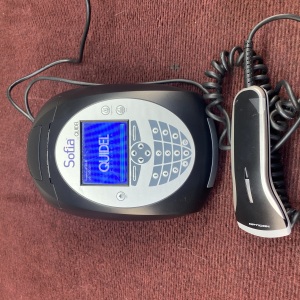Description
Section 1: Introduction
General Description and Intended Use
The Hematek Slide Stainer, shown in Figure 1-1. Hematek Slide Stainer is a fully automated, bench-top instrument designed specifically for the staining of hematology slides for in vitro diagnostic use. This self-contained precision instrument accepts, conveys, fixes, stains, and delivers dry blood smear preparations that are spread on standard thickness 25-mm x 75-mm or 1″ x 3″ glass slides. The slides are stained at the rate of one slide per minute.
Two conveyor spirals move the slides along the platen. Three sensing switches are
triggered sequentially as the slide moves along the platen. Each switch activates its
respective solution pump, which meters and delivers the stain, buffer, or rinse into the
capillary space between the slide and platen. After staining and rinsing have been
accomplished, the slide is dried by a flow of air from a low velocity blower and it is then
deposited in a slide drawer.
Optimal results with the Hematek Slide Stainer are obtained by using one of the Hematek Stain Paks. The Stain Pak consists of one bottle each of stain, buffer, and rinse solutions, and is designed for easy installation and removal from the instrument.
NOTE:
Only Hematek Stain Paks should be used with the Hematek Slide Stainer. Use of other
stain packs or solutions may void the warranty.
Theory of Operation
The Hematek Slide Stainer is designed to produce stained slides of consistent quality in a continuous process. This is accomplished by having a fixed length of time in each of the three phases of stain, buffer, and rinse, as well as a predetermined ratio of stain-to-buffer volumes in the buffer phase.
A properly stained slide is the result of an interactive process involving the pump
volumes, the mixing process, and the stain-to-buffer ratio. A minimum ratio of 1:2 is
recommended; however, if the platen is filling properly, good mixing is occurring, and the stained slides are acceptable under the microscope, the stain-to-buffer ratio should not be adjusted.
Levelers
The feet under the front corners of the instrument act as levelers and may be adjusted to
raise or lower the instrument to a level position. Observe the circular bubble level to verify that the feet have been properly adjusted and the instrument is level.
Conveyor Spirals
The conveyor spirals are two parallel spirals with opposing grooves. Slides to be stained are fitted separately into the opposing grooves, which move the slides across the staining
surface. When loading slides onto the instrument, the side covered by the blood smear is
faced to the left of the operator, with the feathered edge to the back of the instrument.
Slides are moved by the conveyor spirals side by side, from right to left, first at the vertical
plane, then at the horizontal plane with the blood smear facing downward toward the
Platen.
Platen
The platen spans the entire front of the instrument, between the conveyor spirals. The
outside ridges of the platen are elevated guide rails, which give support to the slides as
they are moved along the plate. It is a precision-machined component made from a high-performance plastic polymer material and is designed specifically for two main functions:
1. It maintains the exact volumes of the required solutions within a capillary space
between the plate and the slide.
2. It provides a mixing system for the stain and buffer.
The platen also provides the necessary time interval after the rinsing step for proper drying of the slides before they are deposited in the slide drawer. A trough around the perimeter of the platen allows for drainage of used solutions into the waste tank below.
Slide Drying System
The dryer is a blower type fan that runs continuously when the instrument is in operation. The airflow serves to cool the mechanical components inside the Slide Stainer, as well as to dry the slides.
Slide Drawer
The slide drawer is located below the left end of the platen. It receives the slides as they
drop from the platen after being stained, rinsed, and dried. The drawer will hold 100
slides.
Waste Tank
The waste tank is located underneath the platen and collects used and overflow staining
solutions. The waste tank should be emptied and rinsed once each day and whenever a
New Stain Pak is installed. Refer to Section 5: Maintenance for more information.
Volume Control Panel
The volume control panel tips out from the right front corner of the instrument and
contains three graduated adjustment knobs. The volume of reagent being delivered can be adjusted by rotating the respective control dial clockwise to increase the volume or
counterclockwise to decrease the volume.
Solution Pumps
The instrument has three pump assemblies, one for each solution. Each assembly consists of a pump motor, four rollers that are attached to the underside of a pump cap, and a pump arm. All work together to maintain a constant metering speed to provide consistent volumes of stain, buffer, and rinse, even though the line voltage may fluctuate. The amount of solution pumped is electronically adjusted through the use of the volume control knobs.
Pump Tubing and Cannulas
The pump tubing is provided as a set of three separate pieces of tubing. Notice that each
pump tube is identified with a number and symbol, which corresponds to the reagent
carried by the tubing:
-
1 for staining
-
2 for buffer
-
3 for rinse
Each tube has a clear plastic cuff that fits snugly up to the pump arm and holds the tube in
position without slippage. The tubing is a special type of rubber that is resistant to
leaching and brittleness. The special diameters and lengths of the tubing assure precise
measurement of solutions. Each pump tube is connected to a cannula that is inserted into the appropriate bottle in the Stain Pak. Three cannulas are provided with the Hematek Slide Stainer. With proper routine cleaning, the cannulas can be used for an extended period of time.
Sensing Switches
The sensing switches are three finger-like devices located just above the back edge of the platen. When contacted, the respective sensing switch is activated, which tells the instrument that a slide is in position for the pump to run. After a specific time delay, the pumping motor for the specific reagent is activated. The solution pumps are set so that precise volumes of stain, buffer, and rinse are delivered to their respective areas on the platen. Each reagent is delivered through its respective cannula and tubing network to the platen orifice. The capillary space between the slide and the platen is then filled with the measured volume of reagent.
Operating Lever
The operating lever is a multiple function, bar-shaped lever located at the front left side of the instrument, near the top. The three positions of the lever are labeled and their related functions are as follows:
-
Unlock releases the pressure of the reagent pump arms against the pump tubing.
-
Lock locks the reagent pump arms into their proper position against the pump tubing.
-
Prime provides an override control to allow the pumps to run continuously so the tubes can be primed with solutions and cleared of air bubbles. The lever must be held continuously in the PRIME position. When released, it returns automatically to the LOCK position.
POWER Light
The green POWER light is located at the right side of the instrument near the top. When the instrument is turned on, the light illuminates.
LOW STAIN Light
The yellow LOW STAIN light is to the left of the POWER light. It is off under usual operating conditions; however, when the Hematek Stain Pak contains sufficient reagents to stain only about 20 slides, a weight-sensing device activates the circuit and illuminates the light. The Stain Pak should be replaced at this time.
Power Module
The power module is located on the rear of the instrument; on one side of the module is the panel that contains the line cord receptacle, fuse, and power switch. The power module converts the line current coming into the instrument to 12 volts DC, which is the voltage within the instrument.
Line Cord Receptacle
The line cord connects into the line cord receptacle, which is located at the top of the panel on the power module.
Fuse Holder
The fuse holder, in the center of the panel, holds the fuse that protects against serious electrical overload. A spare fuse is also located in the fuse holder.
ON / OFF Switch
The ON/OFF Switch is located at the bottom of the panel and controls all power to the instrument.
Specifications
Disposal of System Waste and Supplies
Laws and regulations enacted to protect the environment and to encourage resource
conservation require the disposal of hazardous and biohazardous wastes in a specified
manner. Some of the wastes from the Hematek Slide Stainer can be classified as hazardous or biohazardous wastes. It is essential that the laboratory take appropriate steps to determine the laws and regulations applicable to their disposal and to effect compliance. If it is necessary to sample instrument wastes and effluent in order to evaluate compliance with applicable regulations, the laboratory should contact a local licensed biohazardous waste disposal firm for assistance.
The principal wastes associated with the use of the Hematek Slide Stainer are pump and underplaten tubing, effluents from the staining operation, and the container for stain, buffer, and rinse.
Slides with human specimens, control materials, and all reagents, should also be handled and disposed of in accordance with the prevailing regulations and guidelines of agencies with jurisdiction over the laboratory. Refer to the product label and to Material Safety Data Sheets for details concerning any special precautions related to the handling of Hematek Stain Pak containers. Material Safety Data Sheets are available from Siemens.
Overview
This section provides detailed installation and setup instructions for the Hematek Slide Stainer. The installation steps must be followed correctly to ensure proper installation, operation, and service. Read this Operator’s Guide carefully before attempting to operate the instrument. Follow all instructions carefully.
The Hematek Slide Stainer is a precision instrument and must be handled accordingly. Rough handling or dropping of the instrument will disturb or damage internal components. Always handle the instrument with care.
Environmental Factors
As with all sensitive electronic instruments, prolonged exposure to excessive humidity and temperature should be avoided. Temperature should be held relatively constant to obtain the highest degree of operating stability. The ambient temperature range for operating the instrument is 18ºC to 30ºC (64ºF to 86ºF). The ambient operating humidity range is 20% to 85% relative humidity.
Place the instrument in a well-ventilated area, avoiding exposure to corrosive vapors or temperature extremes. Be sure it is near a power source that meets the electrical requirements (voltage) specified on the rating label located on the rear of the instrument. Avoid proximity to open windows, sinks, ovens, hot plates, open burners, radiators, and dry ice baths. The instrument should not be used in an explosive atmosphere.
Instrument Setup
Complete the following procedures to ensure proper installation and performance of your Slide Stainer.
Level the Instrument
-
Raise the hinged lid of the instrument and locate the circular bubble level.
The circular bubble level is located on the instrument panel to the left of the reagent
pumps, directly behind the operating lever.
-
Adjust the two feet located under the front corners of the instrument to raise or lower the instrument to a level position.
-
Observe the circular bubble level to indicate when the feet have been properly adjusted and the instrument is level. The bubble in the level should be centered within the inscribed circle.
NOTE:
If necessary, make a final leveling check and adjustment by watching the flow of the waste fluids during staining. Fluids should flow evenly to the drain hole at the left-front corner of the waste trough.
Plug the Line Cord into an Outlet
Plug the appropriate end of the line cord into the instrument and the other end into an
appropriately grounded AC electrical outlet
Performance Check (Prior to Installing Tubing)
-
Turn the instrument on by pressing the ON/OFF switch, located on the left side of the power module at the rear of the instrument, to the ON position. The green POWER light illuminates, the fan starts, and the conveyor spirals slowly revolves.
-
Inspect the slide dryer area for noticeable airflow.
-
Place five blank slides into the grooves on the right side of the conveyor spirals.Be sure the slides are positioned in opposing slots, parallel to the inscribed lines on the platen.
-
Allow the slides to automatically feed onto the platen.
-
As the slides move down the platen, make sure the leading edge of the slides contact and activate each of the three sensing switch fingers, located along the back wall of the platen above the platen trough. As each switch is activated, the appropriate pump activates and you are able to observe the pump cap rotating.
-
If the instrument functions properly in these steps, continue with the instrument setup procedures.
-
If a problem occurred, contact the your local technical support provider or distributor. Refer to Section 8: Service, Supplies, and Replacement Parts for more information.
Install the Pump Tubing
-
Remove the three cannulas and pump tube sets from their packaging.
Notice that each pump tube is identified with a number, which corresponds to the
reagent carried by the tubing:
-
1 for staining
-
2 for buffer
-
3 for rinse
-
Attach the labeled end of each pump tube to a cannula.
-
Push the operating lever down to the UNLOCK position.
-
Extend each new tube to its respective pump (in numerical order from right to left) and thread the end of the tubing into the hole in the pump arm.
-
Push the thumb tab on the pump arm to the extreme left and push the tubing through until the plastic cuff is flush against the pump arm.
NOTE:
If you encounter difficulty in threading the tubing through the pump housing, lift the operating lever to PRIME for just a few seconds. This will cause the rollers inside the pump housing to rotate slightly and relieve the interference. Then return the operating lever to the UNLOCK position.
-
Release the pump arm.
-
Repeat steps 4 and 5 for the other two pumps.
-
Connect each tube to its proper recessed nipple, located on the backside of the circuit board housing.
-
Be sure that at least 7 mm (0.25 in.) of tubing is connected to the nipple for a secure connection.
NOTE:
If it is difficult to connect the tube to its nipple, use forceps or hemostats to grasp and attach the tubing.
Install the Stain Pak
-
Remove the perforated tabs from the Hematek Stain Pak. Insert the carton, with the STAIN bottle to the right, into the well at the rear of the instrument.
-
Make sure the carton is all the way down and resting on the tray at the bottom of the well. The carton should be level when properly installed.
-
Insert the appropriate cannula into its respective bottle by puncturing the center of the indentation on the bottle.
-
Remove the cannula, turn it 1/4 turn, and insert it again into the same puncture.
-
Push the cannula down until the guard at the top touches the plastic container.
-
Repeat steps 3 through 5 for each bottle.
